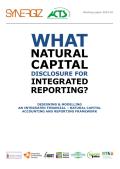
Businesses and government leaders from around the world are increasingly sounding the alarm about the need for effective management of business dependencies and impacts on ecosystems. Though various frameworks and standards have been developed and implemented to improve extra-financial accountability to stakeholders, current sustainability reporting falls short in providing the information needed for accurate investment decision-making. The recent releases of Integrated Reporting (IR) guidelines have been presented as a significant step in the right direction by professionals and academics.
This report, part of a new series by IRENA, explores how renewable energy is financed, produced, distributed and consumed, and will chart the changing relationships it is bringing about between states, corporations and individuals.
This first volume focuses upon the power sector. It tells a story – about the trends driving this change, how the technology is evolving, who is financing it, and the wider benefits it will bring. Finally, it examines what an energy system powered by renewables might look like and how policy makers can further support the transformation.
Africa is well endowed with potential for hydro and solar power, but its other endowments – shortages of capital, skills, and governance capacity – make most of the green options relatively expensive, while its abundance of hydro-carbons makes fossil fuels relatively cheap. Current power shortages make expansion of power capacity a priority. Africa's endowments, and the consequent scarcities and relative prices, are not immutable and can be changed to bring opportunity costs in Africa closer to those in the rest of the world. The international community can support by increasing Africa's supply of the scarce factors of capital, skills, and governance.
This article appeared in the Energy Economics Supplemental Issue: Green Perspectives.

In a clean energy economy, green businesses play a central role by utilizing renewable energy technologies and employing green labor forces to provide clean energy services and goods. This paper aims at analyzing factors driving the growth and survival of green businesses in the U.S. states, with hypotheses proposed on the impacts from clean energy policies and tax incentives, labor market conditions, and economic and political environments. A fixed effect regression analysis is applied with a panel data set of 48 continental states from 1998 to 2007 in the United States. The statistical analysis with a longitudinal data set reveals that the adoption of renewable energy policies, the permission of renewable energy credits imports, the stringency of minimum wage legislations, and presence of clean energy business associations are the major driving forces of the green business development in the U.S. states.
Green growth was a key theme of 2012's Rio+20 conference. There is, however, confusion about what should be sustained: Is it all encompassing development? Is it economic growth, greened or otherwise? Or is it human well-being? This commentary compares these concepts within a framework of sustainability categories. The reality test of measurability points to green growth rather than all-inclusive wealth, welfare or holistic development.
